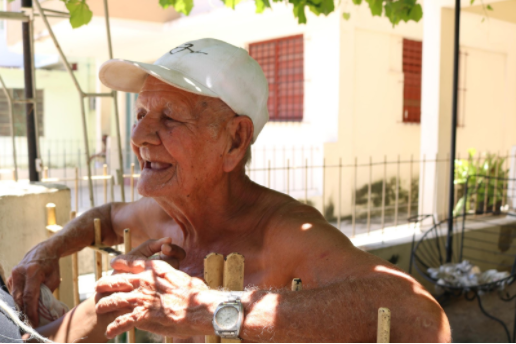Juana Davila
August 27, 2017
Paradise in a dark alley
Old Havana is beautiful during the night; it’s like a never ending fiesta. Parents are out with their children, young couples are taking a stroll while street musicians work their magic, and others are huddled together in the wifi hotspot in front of the public library.
As a foreigner, the restaurant workers will go to you, there isn’t much searching that needs to be done on your behalf. However, you do want to consider the prices because if you do the right amount of searching you’ll be able to find a good deal.
This young man noticed that my classmates and I were looking for a “cheap” restaurant so he approached us and offered his help, free of charge. Despite working for another establishment he led us to a location where we would only pay 5 CUC for a full meal and 1 or 2 CUC for drinks as opposed to the 12 CUC per meal sold at his job.
We were skeptical at first because he led us toward a dark alley but the phrase “never judge a book by its cover” couldn’t have been more perfect for that moment. We arrived at a student hostel, or as it’s called in Cuba, Casa de Estudiantes.
The walls were covered in writing but it was for a reason. Our lovely host told us that after dinner, guests, students or not, were welcomed to leave a message on the walls. That alone stood out to me because most restaurants in the states prevent customers from writing on their walls, yet this particular place wanted their guests to leave their mark.
While some of the messages were just guests’ names, a lot of previous guests took the opportunity to praise the food on the wall.
Since it was late at night, only chicken and pork were available, each with a serving of arroz Moros, which is rice and beans mixed together, potato and cucumber slices. Hostal Loretta made me feel like I was at home, from the flavors in the food to the plates we were served in; it was authentic Cuban food. The service matched the meal quality; there was only one waiter and he made sure we had everything we needed.
As we were finishing our flavorful dinner another guest walked in and we casually talked about how delicious the food was. The people in charge of the restaurant gave us plenty of time to socialize before giving us the check which is something that is very common here in Cuba. People on the island actually enjoy their food as opposed to the United States where there is a sense of urgency to eat and leave.
After being in Cuba for several days we were just begging for a meal that felt homemade. Who would have thought that a small building in a dark alley would be the place to find the long sought meal.
A glimpse into Havana’s Universidad de Ciencias de la Cultural Fisica y el Deporte “Manuel Fajardo”
Cuba’s educational system is similar to the United States in the sense that there’s kindergarten, pre-k, primary, middle and high school levels, as well as college. It’s a lot different in the sense that people there aren’t drowning in student loans. When I heard that there was a university dedicated to the physical culture of Cuba I knew I wanted to go. My imagination went wild as to what this school would look like.
Located in what is known as Ciudad Deportiva, the Universidad de Ciencias de la Cultural Fisica y el Deporte “Manuel Fajardo” is the place to be if you are interested in anything related to physical sciences and sports.
I expected the university to look a lot different than it actually did. I knew that it was going to look different compared to the universities in the United States but I didn’t expect it to be the way it was.
It was a somewhat run-down building; there was construction going on so I had to be careful when going up the steps. Some areas of the school weren’t lit so it was very dark. I was surprised that every classroom I got to see had either a fan or air conditioning running. I expected it to look more like a gym than an actual school, but it did not.
The staff at the school were very friendly and open to having a conversation. From the people at the front gate to the two professors I talked to.
I explain to Beatriz Bravo, a professor at UCCFD, what my project was about and she was ready to enroll me into a crash course about soccer. I kindly had to deny the offer but we did exchange contact information and she gave me some advice on how to approach the local soccer boys.
The whole atmosphere at the university was completely different than how it is back at California State University East Bay. I didn’t see anyone rushing down the halls. A group of guys walked out of class together and continued to have a conversation, they were actually socializing! When class ends I usually just wave bye to the people next to me and walk as fast as possible to my car; I never stay and have an actual conversation.
Being that it’s a university dedicated to the cultural fitness, the school has a soccer field, gym, track lanes, pools, and rooms dedicated to different sports. I noticed a boxing gym but it was closed so I couldn’t enter. The baseball field was actually across the street which I thought was interesting.
My overall experience at the Universidad de Ciencias de la Cultural Fisica y el Deporte “Manuel Fajardo” was very interesting in the sense that it was the complete opposite of what I imagined it to be. It didn’t look like CSUEB nor did it look a luxurious gym; it looked like a school where people go to learn and engage in something they love and I think that’s what makes the university so special to the Cuban people.
Cuba’s friendly neighborhood
When you are holding a camera while taking a stroll through Havana’s streets, people are either going to ask you to take a picture or charge you one or two CUC for a photo.
To some extent, I was surprised at the number of people who actually asked me to take their photo. I guess I expected the Cuban people to be more reserved when in reality they are really friendly. I did notice that while they were open to get their photos taken, some were very hesitant about being interviewed which is completely understandable.
A few days ago I went out with some classmates when this older man sitting in front of his house shouted “Pictures.” I then asked him in Spanish if he wanted his picture taken and he said yes. He casually posed and then got up and we started to have a conversation.
When I’m at home I normally don’t stop to have a conversation with a stranger but when in Cuba you do things out of your comfort zone.
The man began asking my classmates, Danielle, Christine and me about our stay in Cuba and whether or not we loved the island. He was pleased to hear that we were enjoying our stay.
Throughout my stay in Cuba, I realized the cultural differences between the island and the United States.
It’s normal for the Cuban people to greet you with a hug and a kiss which could be a bit overwhelming for a foreigner, depending on where you are from. As a Latina, I grew up having to greet people the “Mexican way,” which is similar to how it’s done in Cuba.
Now, in the United States if someone pulls you into them and hugs you and plants a kiss on your cheek, then you may have grounds for a lawsuit. That’s not the case in Cuba. Hugs and kisses are symbols of friendship and unity within the community; Cubans aren’t afraid to be affectionate.
On the same day we met the older man, we walked passed a group of men working who also asked to get their picture taken. They were mixing cement but immediately put their tools down and posed together. They wanted a picture with their “compas,” and you could get a sense of how close they were.







